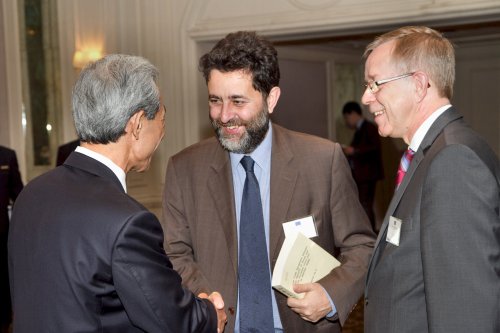In the language of free trade agreements, the phrase “comprehensive deals” usually means long and complicated sections that take many hours to find out how they apply to a given industry.
The European Delegation last week invited representatives of EU companies, embassies of EU member states and local importers of EU products to join in a one-day seminar that covered all aspects related to making the best use of the Korea-EU FTA.
“We are at the final stages of a long process which will culminate with entry into force of the EU-Korea FTA on July 1,” said Ambassador and Head of the EU Delegation Tomasz Kozlowski.

Trade Minister Kim Jong-hoon (left) greets Ignacio Garcia Bercero (center), EU-Korea FTA chief negotiator and the European Commission’s director general of trade, andAmbassador and Head of the European Union Delegation Tomasz Kozlowski. (EUCCK)
High level speakers from EU institutions and from the Korean government provided participants with details explanations of the contents of an agreement that has been labeled by both sides as the “most comprehensive FTA ever signed.”
The EU is Korea’s second largest trading partner and one of its largest foreign investors.
“The stakes are considerable. Our bilateral trade has already reached a level of around 80 billion euros ($114.4 billion) and is growing at a sustainable, fast rate,” he said.
During the seminar, trade experts elaborated on the different procedures necessary to successfully implement the agreement.
“A considerable amount of effort will be needed (by companies on both sides) to recognize new opportunities and to make the changes necessary to fully exploit the new environment created by the FTA,” said Kozlowski.
To assist companies on both sides, chambers of commerce and business associates will play a key role in facilitating this process.
“At the end of the day, it will be up to our companies to make use of the FTA,” he said.
Looking ahead to the implementation of the FTA later this week, 70 percent of tariffs will be duty free on July 1 with the rest eliminated throughout the next few years.
In terms of goods traded, EU exporters of pharmaceuticals, auto parts, industrial machinery, electronics parts, and some agricultural goods and processed foods would be expected to gain from the deal.
Local manufacturers of cars, ships, wireless telecommunications devices, chemical products, and imaging equipment would also be expected to increase their exports to the EU market.
Services on the other hand, while they will make up almost 50 percent of the total trade volume of the newly created FTA, are subject to different rules depending on the industry.
But the greatest economic impact of this FTA would be on specific sectors in each economy.
For example, EU service providers could experience significant gains in the areas of retail and wholesale trade, transportation services, financial services, and business services.
The deal is expected to expand Korea’s services industry by 3.5 percent.
Another big plus for European services firms is that they will enjoy first-mover’s benefits when, and if, the Korea-US FTA comes into force.
Most independent studies done on the potential impact of the agreement estimate that it will have a small but positive effect on the economies of the EU and Korea, with the greatest economic impact of the deal benefitting specific sectors in each economy.
By Yoav Cerralbo (
yoav@heraldcorp.com)






